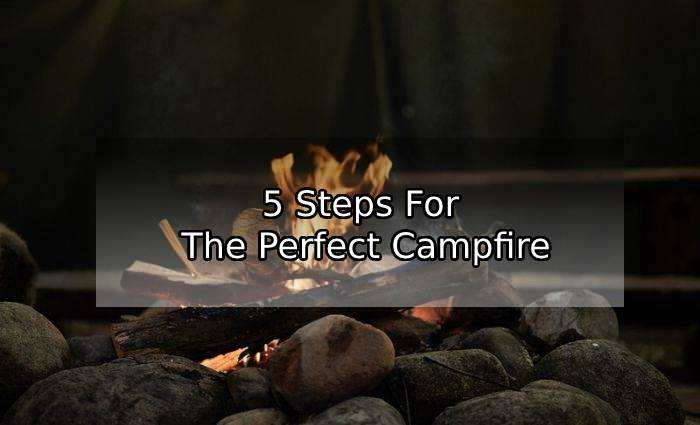Having a great campfire while camping out is an absolute necessity. Whether it is just for S’mores or even more extreme survival purposes, knowing how to make a great campfire is crucial if you want to have an enjoyable experience next time you are in the outdoors.
Knowing how to assemble a long burning campfire will not only insure you a good time, but it can also make you some friends on a chilly night. In more dire situations a fire can also be a way to purify water, ward off hypothermia and dry clothes. There are definitely a lot of ways to assemble campfires, but the steps outlined below keep it simple, safe and effective.
Table of Contents
Step 1: Make The Firebed For The Campfire
When campfire comes to mind, most of us picture the iconic blazing fire with a ring of rocks acting as a barrier between the fire and everything else. There is a problem with using a ring of rocks though and should be avoided. While the idea of the rock ring is to contain the fire, typically what happens is you have a lot of scolded, blackened rocks laying around the campsite.
It is best to go ahead and remove flammable material away from the campfire. Making sure there are no low hanging branches or tree roots within a few feet and removing dead grass, limbs and leaves within the same area is typically enough to contain the fire. Also make sure that you have set up your fire a far enough away from your tent so sparks and embers will not float in.
Step 2: Gather Tinder, Kindling And Fuel Wood For The Campfire
There are three types of materials used when making a fire: Tinder, Kindling and Fuel.
Tinder is the small starter material. This doesn’t necessarily have to be wood either. Cotton balls soaked in lighter fluid, lent from your dryer, sawdust, dead grass, bird down, charred cloth, or even commercially available fire starters. Personally, I prefer the fire starting logs. I like these because they are easy to start, burn a long time and are hot. They are not always convenient to carry with you though so knowing what other methods are available is always a good idea. If you want to forego the above methods, the traditional method of making tender is scraping either bark or wood shavings off of a larger log with a knife. This method works great if the log is dry.
Kindling is the larger pieces of material. These can be various type of materials as well, just like our tinder. Small twigs (about as round as a pencil), split wood, heavy cardboard and wood that has been doused with a flammable liquid all make good kindling. If you are gathering kindling from around the campsite, make sure you are gathering material that is dry. You do not want to have your fire set up to go and then find out you are using green kindling that will not start….I’ve been there, believe me it really isn’t that much fun.
Fuel wood are the traditional logs that we think of when we think campfire. These typically range in length from 8-10″ and are about as big around as your forearm. Again when gathering fuel material make sure the material is dry. If you had your tender and kindling right, the fuel should ignite easily and burn steadily and slowly.
The idea with the different materials when building a fire is you want to go from highly combustible to less combustible. This will ensure you have a fire that will give you warmth and lighting for however long you will need it. It will also make it easy to restart the fire in the mornings after it has gone out through the night.
Step 3: Assemble The Campfire Structure
For our purposes, one of the most versatile ways to build a fire structure (or what is called “laying a fire”) is the Tepee method.
Basically to lay this fire you will work from the inside out starting with the Tinder and working your way out to the Fuel. You will want to arrange you tinder and your kindling in the shape of a small tepee.
After you have your inner tepee of tinder and kindling built, start stacking your fuel around the smaller tepee in the shape of a larger tepee (be sure to leave enough room to light you inner tepee and have enough space between the logs to allow for sufficient airflow!).
Step 4: Light And Tend The Campfire
To light the tepee you will want to light the tinder on the inside of your inner tepee. Once your tinder has lit your kindling slowly add oxygen to the lit fire by blowing lightly on the inner tepee. This will allow your lit fire to gain heat and more easily light your larger tepee of fuel logs.
Since fire always burns up, this will allow your fuel logs to get a good burn over the whole log. Once your fuel has burned for a bit the fuel logs will start to collapse and fall onto each other towards the middle of the tepee.
Once your fuel logs have burned down significantly, you can add more fuel logs in the shape of a tepee, or you can just start adding logs onto the top of the lit fire.
Step 5: Extinguish The Campfire Properly
One of the most common mistakes campers make when extinguishing their campfire is the dump a lot of water on the fire at one time and then leave it. There are a few problems with this method.
- First, what happens when you do this, if you’ve had a fire that you have been keeping lit over the weekend, there will more than likely be hot embers and ash that are covered up by the burning logs you have currently. When you dump water on a hot fire, it will sizzle and will evaporate and get soaked into the logs on top, leaving the logs below still smoldering.
- Secondly, If you are leaving the campsite for the day and plan to return that evening and lit another fire, if you dump a whole lot of water on the fire at once it will drench your fire bed and make it extremely difficult to get a good fire going.
The best method to use when extinguishing a fire is to use the “sprinkling method”. As the name implies, instead of dumping a large amount of water on the fire at once, sprinkle smaller amounts of water over the whole fire. As you are sprinkling the fire, occasionally stir the fire to insure every bit of the fire has been sprinkled with water.
This method will allow you to adequately extinguish the fire, but will keep your firebed dry so you or the person who will be using the campsite after you, can easily start a fire at will.
After following these steps you should be well on your way to enjoying a great campfire. Always keep safety in mind when you have a lit fire. If you are camping with kids, make sure and keep them a safe distance from the fire. Also, always keep water close by to extinguish the fire if it ever starts to get out of hand.



Comments are closed, but trackbacks and pingbacks are open.